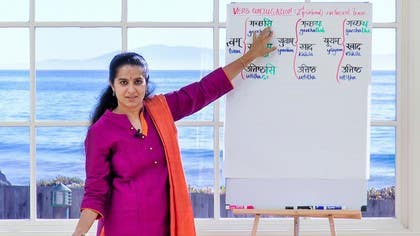Description
About This Video
Transcript
Read Full Transcript
Swagatam dear friends, we've done quite a lot of work with the conjugations of the verbs, the ten simple verbs in the present tense and we've looked at the third person performing these different actions. We've looked at the third person in the singular, the dual and the plural and fortunately for us, the verb ends in the same way when you're talking to the second person formal. So you with respect, singular, dual, plural, masculine or feminine does exactly the same thing. So we'll just go through the different pronouns in the singular third person that's he or saha in the distance. So mind you, when I've put these pronouns out here, especially in the third person, it is only representative of the third person. You can have saha, he or you can have a shaha, he here but if you just learn one of the forms, you would have learned it for all the other pronouns of the same category. So here we have saha, he far, sa, she far, tat, that far in the new term and for the you with respect for a man Bhavan and for a lady Bhavati. So when all of these people are performing an action, fortunately the verb is conjugated as gachati. When all these people go, it's gachati. What you need to remember here is the ti. That's the bija mantra, let's say for the entire group performing an action in the present tense. When we move on to the dual case, the saha, the singular masculine that becomes tau. Remember those two, the feminine saha becomes te, those two ladies, tat, that neutral thing, neutral thing becomes te, te yanani, let's say a car. So we have tau, te, te. So that's again easy to remember there that it's the same thing. And then Bhavan, when you're talking of you with respect becomes Bhavan, tau, you too with respect, male and then when two ladies are being spoken to with respect then it's Bhavatyao. And again good news for us all is that the entire group does it with gachataha, got that? Gachataha, say that, gachataha, lovely. And then we have the plural, so that man, those men is te, those ladies is taha, those things or that neuter objects the tani, you with respect Bhavan becomes for the men Bhavan, taha and for the ladies Bhavatyao. Remember many ladies difficult to handle, so it's like that. So Bhavatyao. So we have again, fortunately for us the entire group goes in the same way. So it's gachanti, note the nti at the end. Now I'll invite you to repeat after me. So we'll just go through each once, once I'll say it and you repeat it once after me, alright. So saha gachati, tath gachati, very good. You formal Bhavan gachati, you lady formal Bhavati gachati, you go, very good. Alright, so gachati, just remember, gachati. Now supposing we were to add another verb here, let's say pat to read. What do you think it would become? If I want to practice this and I want to say all of them are reading and the verb I choose is pattha. What will be the ending now? Pattha, did you say ti? Fantastic, we're getting there. So pattha ti, pattha ti and in transliteration that will be pattha ti, got that? Pattha ti, very good. Let's move on to the dual case. I'll say it once and you repeat after me. But what is really important is that you keep the image, keep the image of the number of people performing that action because that will really help you to get the, in a sense, the neural patterning correct in your mind. Learning a language is also like doing a programming.
So when you are programming in your head and you can very clearly see the logic, then the programming is without any virus and very easy to utilize after that. So when talking of the dual case, those two, those two go, those two ladies go. You can even use two fingers to do that. Those in the neuter, so it could be friends, which is a neuter word with re. So te gachata ha. Now you two men formal go bhavantau gachata ha. Do that. Lovely. You two ladies formal go bhavantiao gachata ha. Fantastic. Now if we had to replace gachata with pathati, so the verb pat, what would it become? So all of that would be pathat and the ending would be, you got it, taha. Pathat, pathat, taha. You or they two read pathat, taha. Lovely. Pathat, taha. Lovely. And then when we move on to the plural, we get the ki singular becomes te. So it's those go, te gachanti, the men, te gachanti. Lovely. Those ladies go taha gachanti, taha gachanti. Lovely. Those friends tani gachanti. Fantastic. Many men you formal go bhavantau gachanti. Lovely. And many ladies go bhavantiao gachanti. Lovely. Now you know the next part is we try and use the word pathat. What would happen to the verb patha? It would become patthanti. Very good. So here we go. Patthanti. So patthanti.
Lovely. And in the transliteration, there we are. So we've looked at it. So we are more and more familiar with the third person conjugation of the verbs as well as the you formal conjugations. So just close your eyes once now and I'll just tell you the verbs conjugated in the singular dual and plural and the third person's doing it or the you formal doing it. So close your eyes and listen to me. Gachati, gachat, taha gachanti. Say that. Gachati, gachat, taha gachanti. Very good. Now we'll say it with the verb patthati to read. Close your eyes again. Patthati, patthat, taha patthanti. Say that. Very good. We'll just try another verb in this category. Lik to write. Likhati, likhatah, likhati. Fantastic. Alright. So just memorise this likhati, likhatah, likhati. That's a homework you can't escape but it's very little considering that it acts as a bijam mantra for so many pronouns. And like I told you these are only representative. All the other pronouns that are of the third person nature will all get the same form of the verb. Alright. So practice. Don't lose heart. We'll get there slow and steady but we'll get there altogether.







You need to be a subscriber to post a comment.
Please Log In or Create an Account to start your free trial.